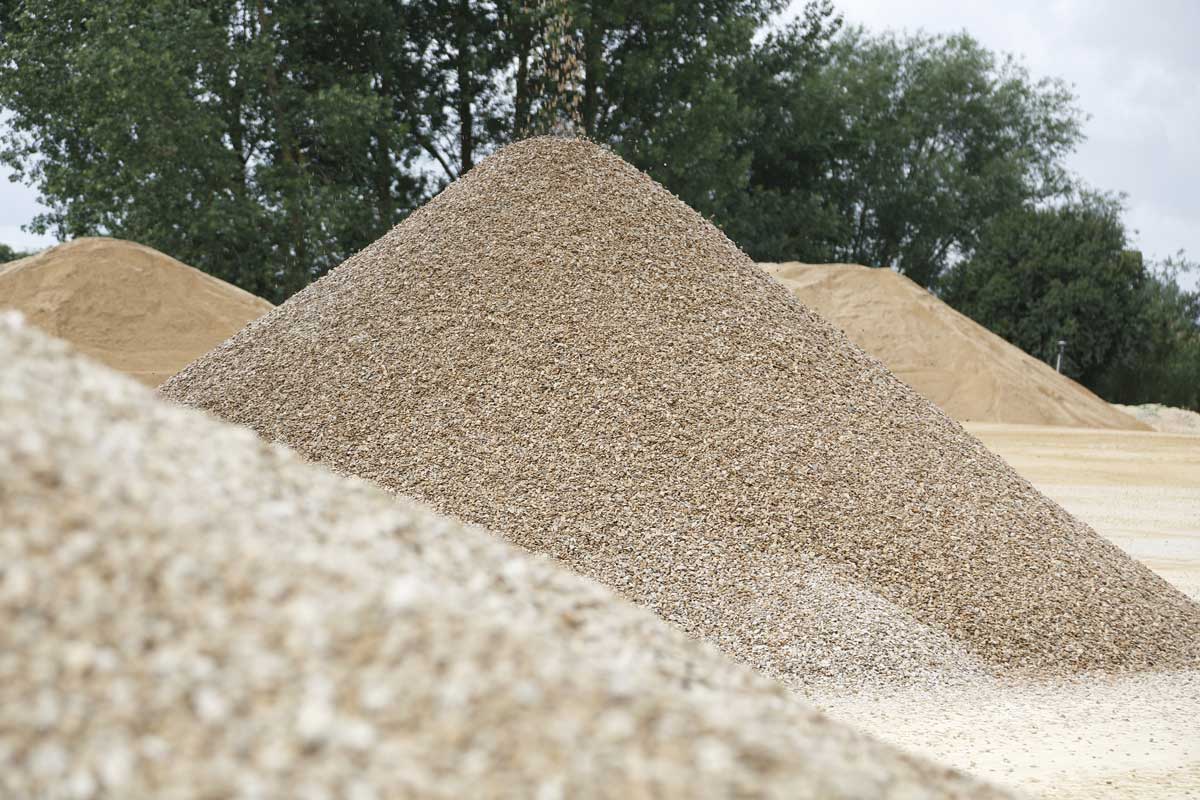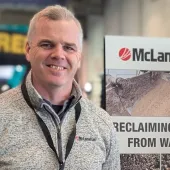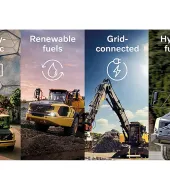Don't Be Complacent About The Future Supply of Aggregates

First published in the September 2022 issue of Quarry Management as 75 Years of a Curate’s Buffet
In his recent keynote speech to the MPA/RTPI conference, Nigel Jackson, chief executive of the MPA, once again warned of the need to shake off complacency about the future supply of aggregates
The history of planning for aggregates is closely linked to the birth of the planning system in 1947 with the first Town & Country Planning Act intended to support the post-war recovery. In no time AHS Waters in his report for government in 1948 identified the ‘the need for maintaining adequate sand and gravel supplies at a cost which is reasonable in all the circumstances’. Policy activity relating to minerals within government advanced by the publication in 1949 of Lord Westwood’s Mineral Development Committee report which considered mineral resources thought not to be abundant, mainly metalliferous and non-metalliferous industrial minerals such as barytes, potash, ball clay, and china clay.
In 1967, the ‘Mineral Resources Consultative Committee’, a pan-government group supplemented by senior Institute of Geological Sciences (now the British Geological Survey) personnel, was formed to ‘to identify UK problems associated with the availability and use of mineral resources’. The committee included two of the geological ‘greats’, ie Professor K.C. Dunham and my nemesis Professor T. Neville George. The ‘great one’ conducted my viva after my finals in 1974. He, the guru of Welsh geology, me an upstart. Somehow, an initially genial exchange of views quickly descended into a bust up over the ignimbrites and greywackes of North Wales and the geology of Pembrokeshire. A bad mistake which still haunts me to this day!
But the seminal moment for all who have been involved with the aggregates industry over the last 50 years was Sir Ralph Verney’s Royal Commission (yes, a Royal Commission!) in 1975, ‘Aggregates – The Way Ahead’. Coupled with Sir Roger Stevens report in 1976, ‘Planning Control of Mineral Workings’, it took some 25 years from the birth of the planning system for mineral planning, and most importantly aggregates mineral planning, to really emerge. Further evolutions followed with the publication of key mineral planning guidance documents, the ‘MPGs’, in 1994.
MPG6, my personal favourite, was particularly significant and nursed me and many others through far too many public inquiries and botched cross-examinations. Guidelines replaced MPG6 in 2003, until Mineral Planning Statement 1 was published in 2006 and endured until the foundations for the current approach were established in the Localism Act of 2011 and enshrined in the National Planning Policy Framework (NPPF), Planning Practice Guidance and consequent Local Aggregate Assessments.
In my opinion, this last set of evolutions was when all the positives created over the previous 30 years of evolution started to corrode and morph into the predicted problems articulated by the industry at the time. We feared that the shift from ‘top down to bottom up’ would sow the seeds for an inevitable crisis in planning for the future supply of aggregates, with consequent shortages. Not an if, but a when. Once the ‘top down’ approach switched to ‘bottom up’ the need for aggregates at both local and more regional scales became far more contested and parochial with no real strategic checks and balances other than through a not-too-clever appeals system.
So where are we today? We remain fortunate that our rich and diverse geology creates abundant resources. However, resources are not evenly distributed by type, quantity, or quality, and a raft of local, national, and international designations constrain what is potentially accessible. Consequently, the stock of permitted reserves of land-won primary aggregates in England and Wales continues to reduce from over 7 billion tonnes back in 1975 to less than 4 billion tonnes today and falling. To many, this may induce a ‘nothing to see here then’ reaction, but just because this is a large number does not mean there is not a problem given the very high levels of consumption each year.
Not only is the quantum of reserves becoming an issue but the disproportionate imbalance between crushed rock, particularly in the South West and East Midlands, as a percentage of total reserves compared with sand and gravel is becoming increasingly telling. Replenishment rates for land-won sand and gravel remain stubbornly low, locked in at around 60% or less over the last 10 years, with soft sand and high PSV becoming even more scarce or less accessible. Replenishment rates for crushed rock, currently at around 73%, are not much better, and while large new permissions can alter this, big extensions are not getting easier to secure nor landing very frequently. The overall picture is of land-won sand and gravel declining faster than rock, with rock substitution for traditional sand and gravel end-uses increasing its consumption rate.
Nationally important large and rail-linked rock quarries are strategically important in knitting together and underpinning national, regional, and local supply, but as the reserve base at each needs to be maintained, the strategic consequences of failure become stark. Replacing just one large ‘big banger’ would require possibly a dozen or so reasonable-size sand and gravel quarries, and the ‘localist’ approach is unlikely to deliver at this scale. Arguably, they may be too big to fail. Nor should we overlook the fact that no new rail-linked greenfield site has now been sought let alone granted planning permission for well over a generation. Rail depots themselves are also under pressure from redevelopment as are both coastal and inland wharves despite safeguarding policies.
Simply put, resources are becoming constrained by over-designation, the permitted reserve base is depleting and increasingly skewed, fuelled by low and sub-optimal replenishment rates and uneven distribution, and scarcity is becoming an increasing issue for soft sand and high-PSV stone. These factors combine to mean the need for new permissions and more reserves is growing. At the same time the planning and permitting process is getting harder, slower, less predictable, and more expensive. It is far from being fixed. In fact, it is far worse, as minister after minister thinks their initiatives will improve the system, but they are never in post long enough to witness their own failures.
Other sources of supply are not without their own issues. The UK is, I would argue, a world leader in the recycling of inert construction and demolition waste and other waste streams, such as asphalt planings, and the use of secondary aggregates from china clay and slate workings for use as aggregate. Some 30% of demand is being supplied by non-primary materials, but these too carry uncertainties. More re-use on site of brick and concrete will reduce the amount of material available for use in the general market, as will more re-use of buildings. For all we know we may already have ‘maxed out’. I think this is highly likely and the harsh reality is that for the foreseeable future the vast majority of demand and any growth in demand will have to be met from primary aggregates and not recycled and secondary aggregates.
In its 2017 paper ‘Long-term scenarios for aggregates’ the MPA projected that between 3.2 billion and 3.8 billion tonnes of primary aggregates would be needed to meet demand to 2030 from the main constituents of supply, ie primary land-won and marine sand and gravel and rock and secondary and recycled materials. This work is in the process of being updated and is likely to show that over an equivalent period the quantum required has edged up to around 4 billion tonnes by 2035.
The industry will clearly need to continue to invest in aggregate-bearing land and build up sufficient new potential sites, extensions, and capacity to supply by submitting planning applications at the right rate to help keep supply at required levels. Equally, mineral planning authorities and statutory consultees will need as much capacity and capability as they have ever had to manage the consequent and continuing workload. Maintaining ‘a steady and adequate supply of aggregates’ is a critical shared endeavour for the public good. It requires private investment and a well-resourced public sector that can manage the flow of applications.
And of course, there is the sleeping giant of 2042 when many extant mineral planning permissions will end unless time extensions have been secured. Currently, the MPA estimates, based on work commissioned from BGS, that around 75% of reserves covered by existing permissions in England and Wales are ‘at risk’ from this end date. Given that lead times from identifying sites with geological potential to securing a planning permission and commencing extraction can typically take 10 to 15 years, we really have up to 2027 to ‘work out what to do and how to do it’ to avert what would be a massive national strategic mineral resource availability and supply shock. The implications of 2042 do not just relate to primary aggregates, but capture all mineral permissions including cement and lime, industrial sands, clays, and building stone. As a consequence, the economic risks of getting this process wrong would be far reaching for many important supply chains.
In summary, supply cannot be assumed and really does need to be planned, monitored, and managed based upon sound data and hard evidence. This is where the Managed Aggregate Supply System (MASS) is so vital and where the Department for Levelling Up, Housing and Communities (DLUHC) and its officials are so important. We need experienced officials with industry know-how and corporate memory, and a practical sharp-end knowledge about the operation of the mineral planning system and confidence to inform and influence politicians.
The old myths that multiple large coastal quarries (or so called ‘super quarries’ as they were unhelpfully badged) or more imports, more recycling, or anything other than local land-won extraction supported by marine-dredged sand and gravel can solve the challenges have long been dispelled. There is a supply storm coming and it can only be weathered by more applications from industry, efficiently and professionally processed by well-remunerated and respected planning officers against a backdrop of strong national policy and guidance supported by sound evidence of future demand.
Demand at least at historical levels is going to persist. There are no easy fixes that can ‘recycle away the need for more quarries’. Aggregates are essential and are critical to national infrastructure, so why is there still no national statement of need for aggregates and other minerals, and no minister overtly charged with the responsibility to ensure a steady and adequate supply? Critical minerals may be in vogue, but an inadequate and unsteady supply of essential minerals will become just as critical if we are not careful. Our government seems to be unable to think strategically when it comes to the use of land or the supply of food, water, energy, or non-energy minerals.
So, what are the odds that aggregates will ascend in importance within government? Not encouraging. DLUHC has now renamed itself six times in the last 15 years and had no fewer 12 ministers for housing and planning since 2010, a function of which MPs David Cameron, Sajid Javid, Theresa May, Boris Johnson, Robert Jenrick, and Michael Gove all basically admitted was not fit for purpose and needed fixing. At BEIS, whilst there is a minister for construction who acts as gatekeeper for mineral products, we do not enjoy the profile of steel or chemicals and probably never will. We have the devil’s-own job just reminding DLUHC that planning does not just mean housing, and that there needs to be an overt recognition with force that planning also means the supply chains that housing, transport, and energy infrastructure rely upon. BEIS seems to be more anxious about lithium and fracking than the biggest material flow in the economy, ie mineral products and particularly aggregates. This is not a choice between essential and critical minerals, it is about minerals and mineral products in totality.
We are fortunate, however, that the county-based system of mineral planning has largely held up despite underfunding, under-resourcing, under-recognition and, as I have said many times, poor remuneration for the challenging work planning officers do. I reject the idea that mineral applications can be processed by generalists. It is a specialist technical skill. We would not expect a general planning officer to handle an application for a major offshore oil and gas field, so why do we do it for an onshore engineered mine?
More capacity and more capability would help reverse the woeful under-provision of mineral local plans. Qualified planners with knowledge and experience of minerals need to be able to balance the real issues relating to a new mineral development and not get lost in the green mist of unevidenced objections from local communities and elected officials looking for any reason to refuse. They need to understand what the industry has achieved over the last 50 years by its contribution to nature. They need to understand how the extraction of essential minerals and the manufacture of mineral products are vital to mitigating and adapting to global warming, and that the operational or whole-life footprint is actually comparatively small when weighed against the benefits to society as a whole. Factoring in decarbonization, the issues of access to resources in an era of geopolitics is not easy for any of us, and for planners caught between communities, councillors, and companies it is a pretty uncomfortable space to occupy.
Companies need to recognize that their ‘licence to operate’ is getting harder to earn and make it easier for applications to be supported by working with communities and planning authorities in order to build trust, by being good neighbours and good corporate citizens, and by being transparent by saying what they will do, doing it, and then proving they did it. Painful as it is to hear given the cumulative burden posed by satisfying planning and permitting requirements, industry has to continue to raise its game and maintain its performance if it wants new permissions. Equally, to encourage companies to invest, government needs to offer a ‘licence to operate system’ which is proportionate, consistent, and reasonable. Too often it satisfies none of these tests.
The MPA has tried over the years to be constructive in providing key information, data, and metrics to help planners and stakeholders and partners understand the bigger picture to inform their deliberations and deal with local elected representatives, and that will continue. Helping stakeholders and decision makers ‘make the link’ is fundamental to improving perceptions.
Looking forward, what can help? First, we need a well-funded and functioning Managed Aggregate Supply System. Unmanaged supply is a recipe for chaos. We might like to recapture the spirit of ‘Verney’ and possibly even restage the seminal debate that took place in the 1970s. Localism was heralded in some 12 years ago. We never thought it was right for aggregates. Too little ‘top down’ imperative from government in a world of enormously effective ‘NIMBYism’ is going to bake-in constraint and under-provision, and there is evidence to show that is happening. Local Enterprise Partnerships (LEPs) that are supposed to strategically determine priorities and drive economic growth are a poor substitute for the excellent strategic planning work of the former ‘Regions’. This should be revisited and the current Aggregates Working Parties (AWPS) re-badged as RAWPs to reflect the reasonable and realistic need for a regional dimension to support a national delivery system.
Landbanks of permitted reserves have been too contentious for too long, but I think it is not a coincidence that the reduction from ‘at least 10 years’ to ‘at least seven years’ for sand and gravel has resulted in lower replenishment rates and looming under-supply. Raising the landbank back to ‘at least 10 years’ for both rock and sand and gravel might be controversial, although I am not sure why it should be. I am sure it would bolster industry confidence to invest in new applications and hopefully with stronger national guidance we could finally end the abuse of landbank arithmetic and unnecessary decimalization. I have always been of the view that ‘capacity to supply’ needs to be given greater weight, particularly if minimum landbanks are to remain at ‘at least seven years’. It is the size of the delivery pipe that governs supply, not just the tank of reserves it emanates from.
When the industry successfully convinced BEIS that the mineral extraction industry should form part of the now discredited ‘Cutting Red Tape’ initiative in 2015, aimed at saving business £10 billion per annum, the MPA and the CBI Minerals Group emphasized the frustration of companies having to submit detailed plans at the plan-making, planning application, and permitting stage for the same features of a scheme. Clearly, this duplication of effort and process is plain daft. Once scheme design elements are accepted in land-use terms as reasonable, they should effectively be ‘banked’ and given weight. By ‘banking and loading’, costs to companies would reduce and the burden on officers would also be reduced, saving time and money for planners, regulators, and developers whilst realizing the same outcomes.
Most companies feel that the process of securing permissions is a ‘can’t do’ uphill battle which bears absolutely no resemblance to the nonsense spouted by successive planning ministers trying to ‘fix a broken planning system’ (their words not mine). The decision to ‘can AMRI’, the Annual Minerals Raised Inquiry which provided sales data by county each year and helped join the dots between the vitally important Annual Mineral surveys, and helped validate AWP reports, was scandalous. It was an act of profound stupidity by government at the time and remains so. The MPA and the CBI Minerals Group continue to argue for its reactivation. These are but some examples of how things could be made to improve but government must walk towards industry acknowledging that planning is not just about housing but also about the supply chains that feed all development and the UK’s ability to deliver commitments and ambitions around net zero and the circular economy.
If industry did nothing but moan about all this proffering no solutions it would be embarrassing and unacceptable. Thankfully, that is not the case. From 2014 to 2018 it embarked on a multi-stakeholder engagement project to develop the UK Mineral Strategy. Finally launched and acknowledged by BEIS at ‘Living with Minerals 6’ in 2018, it provides the framework for ensuring that we can meet the demand for minerals and mineral products sustainably for the next 25 years, likely to be at least 5 billion tonnes. Central to its purpose is the call for a national ‘statement of need’ for minerals and mineral products; something with weight outside of but in addition to the statements in the NPPF. Something which says, in effect, like water, food, and energy, this nation needs non-energy minerals and mineral products. Why? Because they are essential to our economy and quality of life.
We are sleepwalking into a supply crisis. The answer will not be imports, more recycling, more sustainable consumption, more denial. The gap between the reality of continuing demand and likely supply mix is just too great to be plugged by marginal solutions. The uncomfortable and inconvenient truth is that we will need to call on more indigenous land-won resources, both sand and gravel and rock. For a long-term industry it is better that we plan long and deliver progressively rather than wait for the problem to arrive only to discover that the obstacles to unlocking the most essential of our non-energy needs is mired in inertia and, worst of all, ignorance.
Assuming supply is more dangerous than we realize. Now is the time to wake up and get real.








